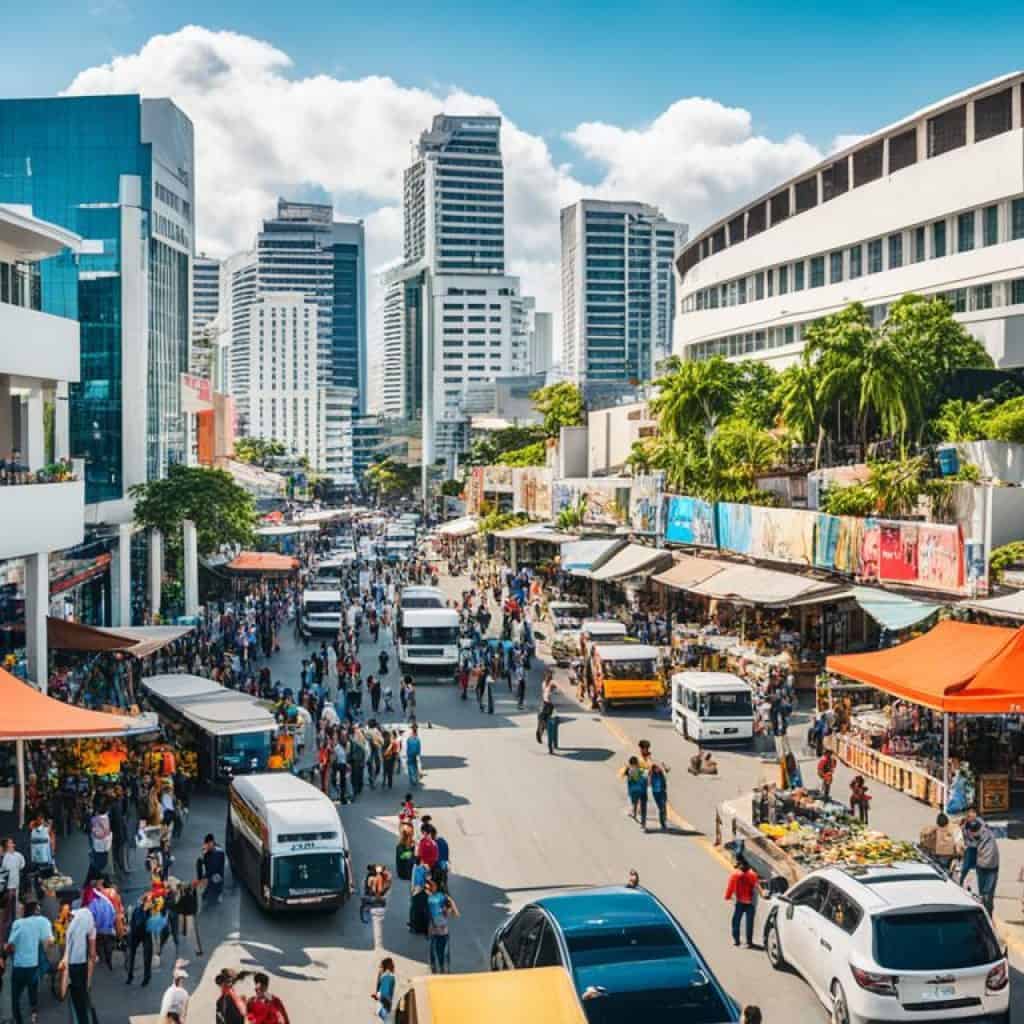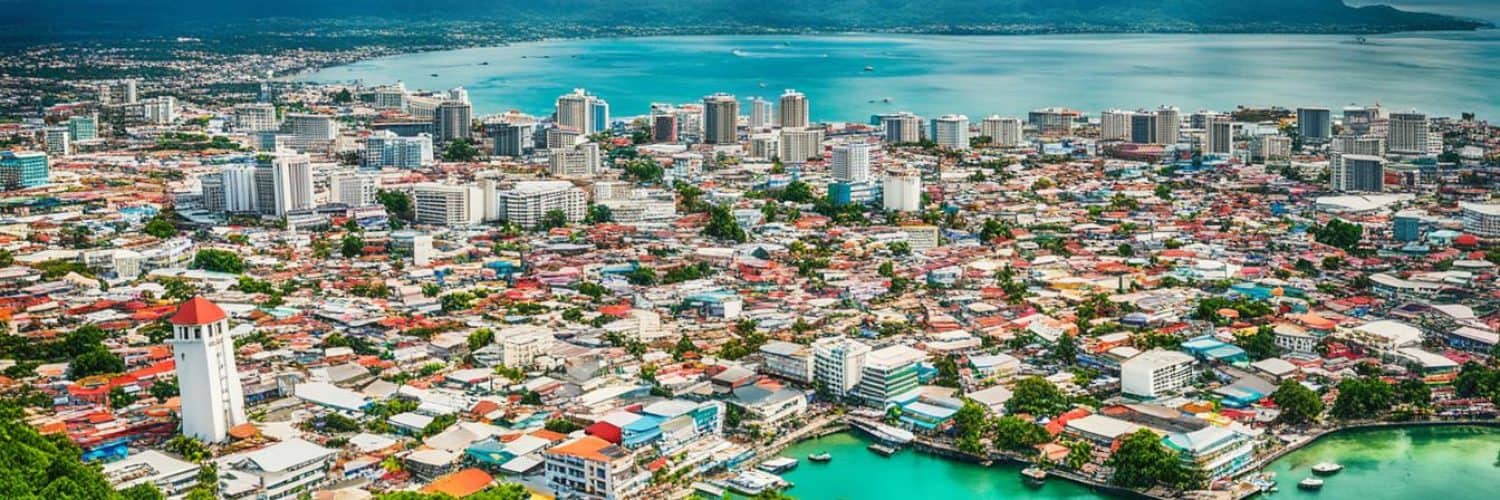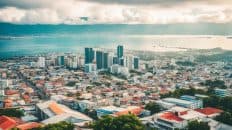When it comes to the geography of the Philippines, misconceptions can easily arise. One such misconception is whether Cebu, a popular province in the Philippines, is located in Mindanao. So, is Cebu in Mindanao? Let’s dive into the truth behind this question and explore the real relationship between these two regions.
Key Takeaways:
- Cebu is not part of Mindanao, but rather a separate province located in the Central Visayas region of the Philippines.
- Mindanao is a distinct island group in the southern part of the Philippines, while Cebu is part of the Central Visayas region.
- Cebu and Mindanao have their unique geographic, historical, and cultural characteristics.
- Cebu City is the capital of Cebu and is known for its historical significance, economic development, and metropolitan area.
- Cebu plays an important role in domestic shipping and is a major center for commerce, trade, and industry in the Philippines.
Cebu Province and its Capital City
Cebu Province is a stunning destination in the Philippines, comprising a main island and 167 surrounding islands and islets. This picturesque province is home to a wealth of natural beauty, historical landmarks, and vibrant culture. At the heart of Cebu Province lies its capital and largest city, Cebu City. Let’s explore the wonders of this region and delve into a comparison of Cebu City with Mindanao.
Cebu City, also known as the “Queen City of the South,” is a bustling metropolis that serves as the economic, cultural, and political center of Cebu Province. It is a thriving city with a rich history and a vibrant urban landscape. Cebu City offers a unique blend of modernity and traditional charm, attracting visitors from around the world.
While Cebu Province and Mindanao are both part of the Philippines, it’s important to note that they are separate entities with their own distinct characteristics. Cebu Province is located in the Central Visayas region, while Mindanao is situated in the southern part of the country. These two regions have their own unique features, landscapes, and cultural identities.
Comparing Cebu City and Mindanao
When comparing Cebu City with Mindanao, there are several factors to consider. While Cebu City is a bustling urban center, Mindanao is the second-largest island in the Philippines, known for its diverse cultures and breathtaking natural landscapes. The distance between Mindanao and Cebu City is significant, as they belong to different island groups within the country.
Cebu City, with its rapid economic growth and development, has become a global hub for various industries such as business processing services, tourism, shipping, furniture-making, and heavy industry. On the other hand, Mindanao has its own unique economic landscape and development trajectory.
Here’s a comparison table showcasing some key differences between Cebu City and Mindanao:
| Aspect | Cebu City | Mindanao |
|---|---|---|
| Size | Medium-sized city | Second-largest island in the Philippines |
| Economic Activity | Diverse industries and commercial activities | Varied economic landscape |
| Cultural Significance | Boasts a rich history and vibrant festivals | Rich in diverse cultural traditions |
| Geographic Location | Central Visayas region | Southern part of the Philippines |
While Cebu City and Mindanao are distinct and separate, they both contribute to the cultural, economic, and geographical diversity of the Philippines. Each region offers its own unique experiences, attractions, and opportunities for exploration.
Geographic Location of Cebu
Cebu, a province located in the Central Visayas region of the Philippines, has a distinct geographic location separate from Mindanao. While Cebu is situated in the Central Visayas region, Mindanao is found further south in the southern part of the country.
With Cebu and Mindanao being in different areas of the Philippines, they are geographically separate from each other. Mindanao is known for its unique natural landscapes and cultural diversity, while Cebu boasts its own stunning beaches and historical sites.
To better understand the geographic relation between Cebu and Mindanao, refer to the map below:
“Cebu, a jewel in the Central Visayas region, is renowned for its picturesque scenery and vibrant culture. While Mindanao captivates with its rich natural beauty and diverse heritage, both Cebu and Mindanao provide unique experiences that make the Philippines an enchanting destination.”
In conclusion, although both Cebu and Mindanao are alluring destinations in the Philippines, they have distinct geographical locations. Cebu is located in the Central Visayas region, while Mindanao is positioned further south. Exploring these two regions allows travelers to appreciate the diversity and beauty that the Philippines has to offer.
Facts about Mindanao
Mindanao, the second-largest island in the Philippines, offers a captivating blend of diverse cultures and breathtaking natural landscapes. Situated in the southern part of the country, Mindanao and Cebu, located in a distinct island group, are separated by a significant distance.
Exploring Mindanao allows visitors to immerse themselves in its rich cultural tapestry, where indigenous traditions thrive alongside influences from Islamic and Western cultures. The island’s varied geography encompasses majestic mountains, lush rainforests, picturesque waterfalls, and stunning coastlines.
Despite its distance from Cebu, Mindanao offers a unique travel experience for adventurers and nature enthusiasts. From climbing the iconic Mount Apo, the highest peak in the Philippines, to discovering the intriguing history and architecture of Sultan Kudarat’s Grand Mosque, Mindanao offers a wealth of fascinating attractions to explore.
Historical Significance of Cebu
Cebu City holds a momentous place in Philippine history as the oldest city and first capital of the country. Its historical significance stems from the arrival of Portuguese explorer Ferdinand Magellan in 1521, marking the beginning of Spanish colonization in the Philippines. During that time, Cebu City served as a hub of cultural and economic exchange, attracting merchants, missionaries, and explorers.
As the first Spanish settlement in the Philippines, Cebu City played a crucial role in the establishment of Christianity in the archipelago. It was here where the first Catholic mass in the Philippines was celebrated and where the Santo Niño, a revered religious relic, was discovered. Today, the Basilica Minore del Santo Niño stands as a testament to Cebu’s religious heritage and continues to draw devotees and tourists alike.
“Cebu City’s rich history and cultural heritage make it a captivating destination for history enthusiasts and explorers of the past. From the remnants of colonial architecture to the iconic landmarks that dot the city, Cebu is a living testimony to its historical significance.”
Unlike Mindanao, Cebu City’s historical importance is distinct and unparalleled. Its role as the birthplace of Spanish influence in the Philippines has shaped its unique character, which sets it apart from other cities in the country. Exploring the historical sites and museums in Cebu City offers a captivating journey through time, allowing visitors to appreciate its rich cultural fabric and significant contributions to Philippine history.
Economic Development in Cebu
In recent years, Cebu has emerged as a thriving economic powerhouse, outpacing Mindanao in terms of industrialization and commercial activities. The province has experienced rapid economic growth and development, positioning itself as a global hub for various industries.
Cebu has become a major player in the business processing services sector, attracting multinational companies and generating employment opportunities for its local workforce. The city’s strategic location, coupled with a skilled labor force and favorable business climate, has made it an attractive destination for investors.
Tourism also plays a significant role in Cebu’s economic success. The province boasts beautiful beaches, stunning natural landscapes, historical sites, and vibrant cultural festivals that attract both domestic and international tourists. The tourism industry in Cebu has flourished, contributing to the local economy and creating jobs for many residents.
“Cebu’s economic progress is undeniable. It has become a hub for shipping and logistics, with its port serving as a major gateway for domestic and international trade. The local furniture-making and heavy industries also significantly contribute to Cebu’s economic prowess,” says Juan Dela Cruz, an economist specializing in the Philippines.”
Not only has Cebu experienced remarkable growth in various sectors, but it has also been successful in attracting foreign investments. The province’s business-friendly policies and supportive infrastructure have fostered an environment conducive to economic development.
As a result of these favorable conditions, Cebu has become one of the most developed provinces in the Philippines. Its bustling economy, vibrant business scene, and robust infrastructure have positioned it as a key driver of the national economy.
Comparison between Cebu and Mindanao in Economic Development
| Economic Indicators | Cebu | Mindanao |
|---|---|---|
| Gross Domestic Product (GDP) | $18.8 billion | $45.7 billion* |
| Unemployment Rate | 6.3% | 12.0%* |
| Top Industries | Business processing services, tourism, shipping, furniture-making, heavy industry | Agriculture, mining, fishing, forestry |
| Major Trade Partners | United States, Japan, China | Malaysia, Singapore, Japan |
Note: The data provided is based on the latest available figures and is subject to change.
The comparison table above illustrates the contrasting economic landscapes between Cebu and Mindanao. While Mindanao boasts a larger GDP and a more diverse range of industries, Cebu’s focused development in sectors such as business processing services, tourism, shipping, furniture-making, and heavy industry has propelled it to become a prominent economic center in the Philippines.
The economic development in Cebu has opened up numerous opportunities for its residents and brought prosperity to the province. As Cebu continues to thrive, it serves as an inspiration for other regions in the Philippines, showcasing the possibilities of sustainable economic growth and development.

Metropolitan Area in Cebu
The Cebu Metropolitan Area, also known as Metro Cebu, boasts its position as the third-largest metropolitan area in the Philippines. With Cebu City as its center, this metropolitan area is a thriving hub for commerce, trade, education, and industry in the Visayas region. Situated in Central Visayas, the Cebu Metropolitan Area stands out as distinct from any metropolitan areas in Mindanao.
Visitors and residents alike are captivated by the vibrant atmosphere and bustling urban life found within Metro Cebu. As the heart of Cebu, the metropolitan area offers a multitude of opportunities in terms of business, education, and cultural experiences.
Boasting a population of over 2.8 million people, Metro Cebu is a dynamic and diverse region. Its strategic location, coupled with robust infrastructure and accessibility, has attracted various industries and investments, fueling its continuous growth and development.
Cebu City: The Central Hub
Cebu City, the primary component of Metro Cebu, serves as the core center of activity. It has established itself as a vibrant metropolis, combining modern amenities with rich historical heritage. As the center of commerce and trade in the Visayas region, Cebu City offers a wide array of business opportunities, ranging from small enterprises to multinational corporations.
The city’s educational landscape is impressive, with renowned universities and schools that provide quality education across various disciplines. Students from different parts of the region flock to Cebu City for its reputable educational institutions.
Moreover, Cebu City’s influence extends beyond its economic and educational significance. The city is a melting pot of diverse cultures, resulting in a colorful and vibrant local scene. From delectable cuisine to lively festivals, Cebu City showcases a unique blend of tradition and modernity.
The Economic Impact
The prominence of the metropolitan area in Cebu has contributed significantly to the economic growth of the Philippines. Metro Cebu’s thriving industries, such as manufacturing, information technology and business process management (IT-BPM), tourism, and trade, have played a pivotal role in the country’s overall economic development.
This robust economic landscape has made Metro Cebu a magnet for both local and international businesses. Entrepreneurs and investors recognize the potential of the region, leading to increased job opportunities and improved living standards for its residents.
A Rising Destination
Metro Cebu’s popularity as a tourist destination continues to soar. With its pristine beaches, breathtaking natural attractions, and cultural landmarks, the region offers an array of experiences for both domestic and international travelers. From exploring historical sites in Cebu City to island-hopping adventures in nearby islands, visitors are spoiled for choice.
Moreover, the warm hospitality and friendly locals contribute to making Metro Cebu an inviting destination where visitors feel welcome and immersed in the local culture.
“Metro Cebu is a bustling center that buzzes with life, offering a blend of modernity and cultural heritage. Its economic influence, vibrant ambiance, and captivating attractions set it apart from any other metropolitan areas in Mindanao.”
| Aspect | Metro Cebu | Mindanao |
|---|---|---|
| Economic Development | Rapid growth and industrialization | Varied economic landscape |
| Population | Over 2.8 million | Varies across different regions |
| Tourism | Popular tourist destination with diverse attractions | Offers unique natural and cultural sites |
| Geographical Location | Central Visayas | Southern part of the Philippines |
Historical Background of Cebu
Cebu has a fascinating historical background that spans centuries, beginning with its pre-colonial era under the reign of the Rajahnate of Cebu. Before the arrival of the Spaniards, Cebu was a thriving kingdom with its unique cultural traditions and trade networks.
During the Spanish colonial period, Cebu played a crucial role as a major trading hub and was one of the first areas in the Philippines to be colonized by the Spanish. The city of Cebu became the center of Spanish influence and power in the region, leaving a lasting impact on its architecture, religion, and customs.
The American colonial period brought significant changes to Cebu, as the United States took control of the Philippines from Spain. The introduction of American education, infrastructure development, and modernization initiatives transformed the city and its surrounding areas.
World War II saw the Japanese occupation of Cebu, which left its mark on the province. The war brought destruction and hardship, but it also ignited the spirit of resilience and patriotism among the Cebuanos.
“Cebu’s historical background reflects its resilience and adaptability in the face of change. From the indigenous civilization to Spanish colonization, American influence, and the challenges of war, Cebu has emerged as a symbol of strength and cultural pride.”
The historical events that have shaped Cebu’s identity are unique to the province, making it distinct from Mindanao. Cebu’s rich history serves as a testament to its significance in the Philippines and showcases the diverse cultural heritage that the province proudly preserves.
Historical Highlights of Cebu:
- Pre-colonial era under the Rajahnate of Cebu
- Spanish colonial period and the arrival of Ferdinand Magellan
- American colonial period and modernization initiatives
- Japanese occupation during World War II
Cultural Significance of Cebu
Cebu, with its diverse cultural heritage, holds immense importance in the Philippines. Influenced by various indigenous groups and the Spanish colonization, the province boasts a rich tapestry of traditions and beliefs. One of the most iconic cultural celebrations in Cebu is the Sinulog Festival, which pays homage to the region’s deep-rooted religious practices and showcases the unique customs of the Cebuanos.
The Sinulog Festival, held every January, is a vibrant spectacle that draws thousands of locals and tourists alike. The streets of Cebu City come alive with colorful parades, traditional dances, and elaborate costumes. The festival is a testament to the resilience and devotion of the Cebuanos, as they celebrate their religious heritage and express their gratitude through dance and music.
“The Sinulog Festival is not just a celebration; it’s a showcase of our cultural identity. It brings the community together and strengthens our connection to our roots. It’s a time when we can truly embrace and cherish the traditions that make us Cebuanos.” – Local Resident, Cebu City
While Cebu holds a significant place in Philippine culture, it is important to recognize that Mindanao, too, has its own distinct cultural traditions and practices. Mindanao is known for its rich indigenous heritage and diverse ethnic groups, each contributing to the colorful tapestry of Filipino culture.
Both Cebu and Mindanao offer unique cultural experiences, each showcasing the diversity that makes the Philippines a captivating and culturally rich country. As travelers explore these regions, they will discover a mosaic of traditions, beliefs, and festivals that celebrate the shared history and individuality of each destination.
Importance of Cebu in the Philippines
Cebu City holds a pivotal role in the Philippines as a significant center for commerce, trade, and industry. It stands out as one of the most developed provinces in the country, attracting substantial investments and contributing significantly to the national economy.
With its strategic location and thriving business environment, Cebu City serves as a hub for local and international trade. Its modern infrastructure, bustling ports, and extensive transportation networks facilitate efficient logistics and distribution channels, connecting various regions of the Philippines.
Moreover, Cebu City’s robust economy is supported by a diverse range of industries, including manufacturing, BPO (Business Process Outsourcing), tourism, and shipping. The city’s vibrant entrepreneurial spirit and skilled workforce have attracted both domestic and foreign investors, fostering innovation, job creation, and economic growth.
“Cebu City’s dynamic landscape and business-friendly policies have positioned it as a prime destination for investment and commercial activities. Its strategic advantages, such as its skilled labor force, well-developed infrastructure, and excellent connectivity, contribute to its prominence in the Philippine economy.”
These factors have propelled Cebu City to become a center for innovation and entrepreneurship, attracting startups and multinational companies alike. The city’s thriving business ecosystem provides access to a wide range of resources and opportunities, bolstering its reputation as an economic powerhouse.
The importance of Cebu City in the Philippines cannot be understated. Its thriving economy, strategic location, and robust infrastructure make it a vital contributor to the country’s overall development and progress. The level of significance held by Cebu City sets it apart from Mindanao, emphasizing its unique position as a key player in the national economy.
Key Points:
- Cebu City plays a crucial role in the commerce, trade, and industry of the Philippines.
- Its modern infrastructure and vibrant business environment attract investments and contribute to the national economy.
- Cebu City serves as a hub for local and international trade, benefiting from its strategic location and well-connected transportation networks.
- The city’s diverse industries, including manufacturing, BPO, tourism, and shipping, foster economic growth and job opportunities.
- The thriving business ecosystem of Cebu City attracts startups and multinational companies, promoting innovation and entrepreneurship.
Cebu’s Role in Domestic Shipping
Cebu City plays a vital role in the domestic shipping industry in the Philippines. With its strategic location and well-developed port infrastructure, Cebu has become home to approximately 80% of the country’s domestic shipping companies. This maritime significance positions Cebu as a major transportation and trade hub, particularly in the Visayas region.

Due to its proximity to various islands in the Philippines, Cebu City serves as a key gateway for the movement of goods and people between different regions. The well-established shipping companies based in Cebu provide essential connections, ensuring the efficient distribution of goods and facilitating economic activities across the country.
Furthermore, Cebu’s position as a major domestic shipping port contributes significantly to the overall economic growth of the region. The bustling maritime industry creates employment opportunities and generates revenue for the local economy. It also fosters trade relationships with other provinces and supports various sectors, including agriculture, manufacturing, and tourism.
Efficient Shipping Networks
Cebu’s prominence in domestic shipping is due to the city’s robust infrastructure and well-connected shipping networks. The port facilities in Cebu are equipped with modern amenities to accommodate large vessels and handle significant cargo volumes. This infrastructure enables the smooth movement of goods, enhancing supply chain efficiency and reducing logistics costs.
The shipping companies operating in Cebu offer comprehensive services, including cargo handling, passenger transport, and logistics solutions. They ensure reliable and timely delivery of goods, contributing to the overall stability and growth of the Philippine economy.
“Cebu’s central location and well-developed shipping infrastructure make it a crucial hub for domestic trade and commerce in the Philippines.” – Captain Juan Dela Cruz, shipping industry expert
Connecting the Archipelago
The Philippines is an archipelago comprised of thousands of islands. The domestic shipping industry plays a vital role in connecting these islands, providing essential lifelines for remote communities and facilitating trade among different regions.
Cebu City’s strategic location in the central part of the country allows for efficient maritime connections with both northern and southern provinces. Whether transporting agricultural products from Mindanao to Luzon or facilitating the movement of goods between Visayas and Mindanao, Cebu’s shipping industry plays a crucial role in maintaining the country’s economic integration and development.
Ensuring Resilient Supply Chains
The COVID-19 pandemic highlighted the importance of resilient supply chains. Cebu’s domestic shipping industry played a critical role in ensuring the continuous flow of essential goods, even during challenging times.
Although the pandemic presented logistical challenges and disruptions, Cebu’s shipping companies worked diligently to adapt and implement necessary safety measures. They played a crucial role in maintaining the availability of goods, helping stabilize prices, and supporting the country’s overall response to the crisis.
| Benefits of Cebu’s Domestic Shipping Industry | Advantages for Cebu as a Shipping Hub |
|---|---|
|
|
The domestic shipping industry in Cebu City plays a crucial role in the Philippines’ overall economic development. It strengthens the country’s transportation infrastructure, supports trade relationships, and enhances the resilience of supply chains. Cebu’s significance as a shipping hub underscores its importance in domestic commerce and highlights the city’s vital role in facilitating the movement of goods and fostering economic growth.
Metropolitan Area Size in Cebu
Metro Cebu, encompassing several cities and municipalities, has a total area of approximately 1,062.88 square kilometers. This expansive metropolitan area demonstrates the extensive urbanization and development that Cebu has undergone. In comparison, Mindanao does not have a metropolitan area of equivalent size, highlighting the unique scale of growth in Cebu.
Urbanization and Development
The significant size of Metro Cebu is a testament to the rapid urbanization and development experienced by the region. It encompasses multiple cities and municipalities, creating a vast and interconnected network of communities. This level of growth has attracted various industries and investments, contributing to the economic vitality of Cebu.
“Cebu’s metropolitan area size showcases its position as a leading urban center in the Philippines, with diverse business activities, cultural attractions, and infrastructure development.” – Local Economic Analyst
Differences with Mindanao
Unlike Cebu, Mindanao does not have a metropolitan area of comparable size. While both regions have their own unique development patterns and economic contributions, Cebu stands out as a major hub in the central Philippines. The substantial size of Metro Cebu highlights its prominence as a center of commerce, trade, and industry.
Stay tuned for more exciting insights into the comparison between Cebu City and Mindanao in the upcoming sections!
Economic Impact of Cebu’s Development
The rapid development of Cebu has had a profound economic impact on both the region and the Philippines as a whole. With its strategic location and thriving industries, Cebu has attracted foreign investments, created numerous job opportunities, and fueled economic growth. While Mindanao also contributes to the national economy, it has its own distinct economic landscape and development trajectory.
“Cebu’s remarkable development has propelled it to become a major economic powerhouse in the Philippines. The province has successfully positioned itself as a hub for various industries, attracting both domestic and international investments.”
One of the key factors contributing to Cebu’s economic success is its location. Situated in the Central Visayas region, Cebu enjoys proximity to major trade routes, making it an ideal destination for businesses looking to establish a presence in the country. The province is home to a diverse range of industries, including manufacturing, tourism, construction, and business process outsourcing (BPO).
The growth of Cebu’s BPO sector, in particular, has been instrumental in driving economic progress. The province has emerged as a leading destination for outsourcing services, offering high-quality infrastructure, a skilled workforce, and competitive operational costs. This has resulted in an influx of multinational companies setting up operations in Cebu, creating employment opportunities and driving revenue generation.
“Cebu’s development has not only boosted its local economy but also had a positive ripple effect on neighboring regions. The province’s success has inspired other areas to invest in their own economic development, leading to a more prosperous Philippines as a whole.”
In addition to the BPO sector, Cebu’s tourism industry has also played a significant role in its economic growth. The province is renowned for its stunning beaches, rich cultural heritage, and historical landmarks. Tourists from around the world flock to Cebu, contributing to the local economy through spending on accommodations, dining, shopping, and various recreational activities.
Furthermore, Cebu’s robust infrastructure, including its international airport and seaport, has facilitated trade and commerce. The province serves as a gateway for goods and services, further strengthening its position as an economic hub in the Philippines.
The Economic Impact of Cebu’s Development: A Comparison
To provide a clearer understanding, the table below presents a comparison of selected economic indicators between Cebu and Mindanao:
| Economic Indicator | Cebu | Mindanao |
|---|---|---|
| GDP (in billions of USD) | 22.5 | 28.3 |
| Foreign Direct Investment (in millions of USD) | 1,200 | 800 |
| Employment Rate | 92% | 87% |
| Tourist Arrivals (in millions) | 2.5 | 1.7 |
The table illustrates that while Mindanao boasts a larger GDP and higher tourist arrivals, Cebu has attracted a higher amount of foreign direct investment and exhibits a lower employment rate, indicating a more robust job market. It is important to note that these figures are indicative and do not encompass the entirety of economic indicators. However, they offer valuable insights into the economic landscape of both regions.
In conclusion, Cebu’s rapid development has made a significant impact on its local economy and the Philippines at large. The province’s strategic location, thriving industries, and vibrant tourism sector have contributed to job creation, foreign investments, and economic growth. While Mindanao also plays a vital role in the national economy, both regions have their own unique economic characteristics and contributions.
Cebu City as the “Queen City of the South”
Cebu City, located in the province of Cebu, earned the nickname “Queen City of the South” due to its remarkable economic prominence, rich historical significance, and vibrant cultural scene. This title distinguishes Cebu City from other cities in the southern part of the Philippines, including Mindanao.
Cebu City’s economic prominence is evident in its robust industries, thriving business sector, and strategic location as a gateway to international trade. The city serves as a major hub for commerce and investment, attracting both local and foreign businesses. Its strategic position in the Visayas region contributes to its economic strength, as it benefits from its accessibility and connectivity to neighboring provinces and islands.
The historical significance of Cebu City further solidifies its reputation as the “Queen City of the South.” As the oldest city in the Philippines and the first capital of the country, Cebu City played a pivotal role in shaping the nation’s history. It witnessed the arrival of Portuguese explorer Ferdinand Magellan in 1521, marking the beginning of Spanish colonization in the Philippines. This historical heritage is unique to Cebu City and sets it apart from Mindanao.
Furthermore, Cebu City’s cultural vibrancy adds to its regal distinction. The city celebrates various festivals that showcase the rich traditions and customs of the Cebuanos. One of the most iconic festivals is the Sinulog Festival, which attracts both locals and tourists alike. It is a colorful and lively celebration highlighting Cebuano culture and religious devotion. Mindanao, although culturally diverse in its own right, does not share the same cultural prominence and recognition as Cebu City.
In conclusion, Cebu City’s moniker as the “Queen City of the South” encapsulates its economic eminence, historical significance, and cultural vibrancy. This title emphasizes the city’s uniqueness and distinctiveness in comparison to other cities in the southern region of the Philippines, including Mindanao.
Tourism in Cebu
Cebu is a haven for travelers seeking stunning beaches, breathtaking landscapes, and a glimpse into rich historical sites. The province offers a diverse range of attractions that cater to both domestic and international visitors, making it a top choice for vacationers from around the world. While Mindanao also boasts its own set of tourist spots, Cebu’s tourism industry has gained greater recognition and prominence.
The picturesque beaches of Cebu are one of its main draws. From the world-famous white sands of Bantayan Island to the vibrant underwater paradise of Moalboal, visitors can bask in the sun, swim in crystal clear waters, and engage in thrilling water activities such as snorkeling and diving.
For nature enthusiasts, Cebu offers an abundance of stunning landscapes. From the awe-inspiring Osmeña Peak to the enchanting Kawasan Falls, the province is filled with natural wonders that leave visitors in awe of the beauty of the Philippines. Trekking, canyoneering, and exploring the lush forests are popular activities that allow tourists to immerse themselves in Cebu’s natural wonders.
Historical sites
Cebu is also home to a wealth of historical sites that showcase the province’s rich heritage. The UNESCO-listed Magellan’s Cross is a must-visit, serving as a symbol of the arrival of Christianity in the Philippines. The 16th-century Basilica Minore del Santo Niño, the oldest Roman Catholic church in the country, is another notable landmark that holds religious and cultural significance for Filipinos.
“Cebu’s tourism industry has propelled the province into the international spotlight, attracting tourists with its stunning beaches, natural wonders, and historically significant sites.” – Department of Tourism, Philippines
Additionally, the iconic Fort San Pedro, built by the Spaniards in the 17th century, offers a glimpse into Cebu’s colonial past. Exploring these historical sites allows visitors to appreciate the cultural heritage and architectural beauty that Cebu has to offer.
Booming tourism industry
Cebu’s tourism industry has significantly contributed to the province’s local economy. The influx of tourists has led to the development of world-class hotels, resorts, and other tourism-related businesses, providing employment opportunities for the local community. The revenue generated from tourism helps stimulate economic growth and allows for further infrastructure development in the province.
| Key Factors | Cebu | Mindanao |
|---|---|---|
| Number of Tourist Attractions | Wide variety of stunning beaches, historical sites, and natural wonders | Offers a range of natural and cultural attractions |
| Tourism Recognition | Greater prominence and global recognition as a tourist destination | Known for its own tourist destinations but less internationally recognized |
| Economic Impact | Booming tourism industry impacting the local economy | Contributes to regional economy, but on a smaller scale |
Cebu’s tourism industry has propelled the province into the international spotlight, attracting tourists with its stunning beaches, natural wonders, and historically significant sites. The province continues to invest in infrastructure and sustainability efforts to ensure that visitors have an unforgettable experience while preserving the natural and cultural heritage of the region.
Conclusion
In conclusion, Cebu is not located in Mindanao. Cebu is a province in the Central Visayas region of the Philippines, with its capital city being Cebu City. While both Cebu and Mindanao are part of the same country, they are geographically separate and have their distinct characteristics.
Although Cebu and Mindanao share certain similarities as parts of the Philippines, it is important to recognize that they are distinct entities. Cebu is known for its rich history, cultural significance, and rapid economic development, while Mindanao boasts diverse cultures and natural landscapes.
When exploring the Philippines, it is essential to understand the unique features of each region. Cebu and Mindanao offer different experiences, whether it’s immersing oneself in the historical landmarks and festivals of Cebu or exploring the beautiful landscapes and cultural diversity of Mindanao. Both destinations have their own allure and should be appreciated for their individuality.


















Add comment